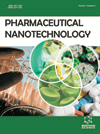- Home
- A-Z Publications
- Pharmaceutical Nanotechnology
- Previous Issues
- Volume 2, Issue 1, 2014
Pharmaceutical Nanotechnology - Volume 2, Issue 1, 2014
Volume 2, Issue 1, 2014
-
-
s Nanoparticles in the Development of Therapeutic Cancer Vaccines
More LessAuthors: Ronak Savla, Vera Ivanova and Tamara MinkoCancer vaccines have garnered great interest as a potential arsenal to treat patients with cancer. The main goal and challenge in cancer immunotherapy includes the activation of the otherwise indolent immune system of cancer patients. It has been discovered that cytotoxic T cell mediated immune response is most efficacious in killing cancer cells. However, even if the immune system of a cancer patient is activat Read More
-
-
-
The Multifaceted Potential of Electro-spinning in Regenerative Medicine
More LessAuthors: Kieran Fuller, Abhay Pandit and Dimitrios I. ZeugolisThe increased interest in nanotechnology has resulted in an intense investigation and development of nanofabrication methods. Among the bottom-up approaches, electro-spinning has attracted great interest in recent years. The popularity of electro-spinning lays on the fact that it is a relatively simple and economic technique that enables production of large quantities of nano- to micro-meter range fibrous materials wi Read More
-
-
-
Transfection Optimization of Hyperbranched Poly 2-Dimethylaminoethyl Methacrylate (pDMAEMA) based Polymers In Vitro
More LessAuthors: Asha Mathew, Wenxin Wang and Abhay PanditThe present study reports the transfection and cytotoxicity of hyperbranched poly (2-dimethylaminoethylmethacrylate) (pDMAEMA) based polymer at various physiological conditions. Transfection capability and cytotoxicity of the hyperbranched polymer were first evaluated by varying the molecular weight upon PEGylation. Hyperbranched polymer with optimal PEGylation was later protonized and the effect of protonation w Read More
-
-
-
Cellular Response to Ferroelectric PVDF-TrFE Nanoscale Surfaces Formed by Varying Polymer Concentration
More LessPoly[(vinylidenefluoride-co-trifluoroethylene] [PVDF(TrFE)], a ferroelectric polymer capable of undergoing strain of up to 7% is both highly chemically resistant and has the advantage of being cytocompatible. Here we present a preliminary study into the response of mesenchymal stem cells to spin-coated PVDF(TrFE) films and examine how the polymer concentration influences electrophysical film properties and cell adh Read More
-
-
-
Effect of Piperine, Quercetin, Polysorbate 80 on the Oral Bioavailability of Losartan in Male Wistar Rats
More LessAuthors: Swathilatha Rewanthwar and P.K. LakshmiScope: P-glycoprotein (P-gp) is found to play a very significant role in intestinal transport of losartan, an antihypertensive drug with variable and low oral bioavailability (33%), is a substrate for both CYP 3A4 and P-gp. This makes P-gp inhibition a logical strategy for improving losartan’s oral efficacy and reducing its toxicity. Thus, we investigated whether the co-administration of piperine, quercetin, and polysorbate 80 could in Read More
-
Most Read This Month
Article
content/journals/pnt
Journal
10
5
false
en


